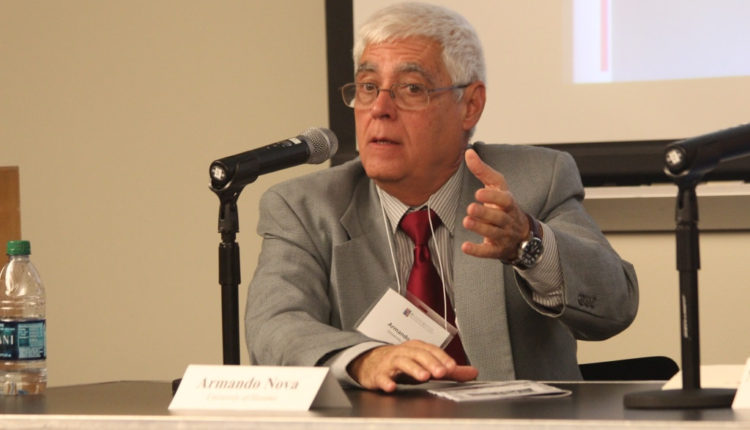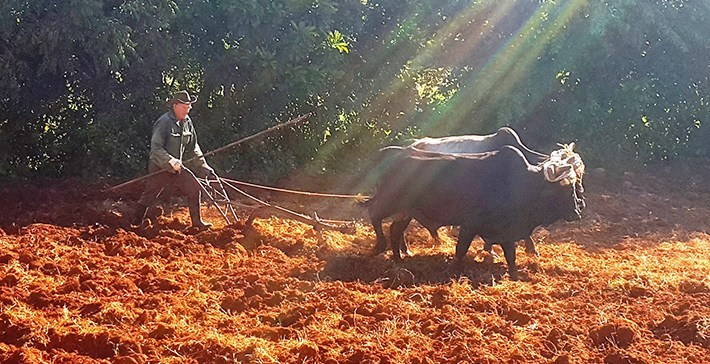 Cuban economist Armando Nova
Cuban economist Armando Nova
Cuba’s agriculture dilemma: Decrees for insomniacs
Food security in Cuba is one of those issues that affects all of society, in all of its stages. Especially for some and at those moments of the day when it is time to eat.
The Cuban agricultural model’s problems and the attempts to resolve them have been enumerated, and still the authorities always return to the same failed solutions. As a matter of national security, as has been recognized on countless occasions, it is inexplicable that in Cuba there be the absence of systemic and consequential actions, not only with the socialist project that is proposed as a goal, but with the daily life of its people.
Cuban economist Armando Nova, who specializes in the socioeconomic sector, knows of this black hole. He says that this is the institutional space where the most measures and transformations have taken place during the country’s process of updating the economic model. “As far as I remember, there have been more than 22 [measures], and new ones continue to be added. Therefore, the question arises: If this is where the most transformations are being incorporated, then why have we not seen an increase in results of production?”
Centralization, one step forward and two steps back
Among the obstacles that grow and strengthen in agricultural production processes, Professor Nova mentions the levels of centralization at each stage. In a previous article, “Cuban agriculture between autonomy and centralization,” Nova writes: “In the Cuban agricultural sector there is a resurgence and an increase in centralization and the reduction of autonomy, in particular of Credit and Services Cooperatives (CCS) and of Agricultural Production (CPA), as well as a decrease in the role and performance of the National Association of Small Farmers (ANAP).”
He is referring to what was specified in Decree No. 355, issued last April 17. The legal norm is the result of an experiment that began in January 2016, when the newspaper Tribuna de La Habana announced the expansion of the network of State Agricultural Markets in Havana, supplied by the agricultural companies of Artemisa and Mayabeque, and governed by an official price list with a maximum cap. The action of setting maximum prices was not new at that time, and it is not now.
The new decree states: “Compliance with the commitment to government institutions. The commercialization of released agricultural products is executed after compliance with delivery commitments to government institutions in the quantity, quality, assortments and in the period established, in accordance with the provisions of the contracts signed.”
What is not regulated in the document, as noted by Professor Nova, is the amount stipulated by the government contracts. In an article published in the newspaper Granma, which specifically discusses the issue of contracting agricultural production, it is explained that since there is no dialogue between producers and government representatives what could happen is that “the commitment assumed be lower than what can truly be produced. If you do not check what happens at the source, it is likely that a small but appreciable amount of food will be sidetracked from the established course and end up in the hands of those who set their own prices and mess with other people’s pockets.”
On the one hand, it is assumed that the government must contract most of the production, leaving a narrow margin for the producer’s participation in the market of supply and demand — where he or she obtains better profits and with a more efficient payment system. On the other, it is the idea that scarcity (and with it comes speculation) is due only to the ‘diversion’ of food to the free or black markets. Never are low levels of productivity and / or disenchantment of the productive forces taken into account.
Currently the amounts committed by producers from Artemisa and Mayabeque with the government is unknown because they are not clarified by the new regulation. Nova thought that with the beginning of that experiment the country had taken some steps towards decentralization, at least in the marketing phase, but “a return to the high levels, or close to 75-80 percent or more [government order], to channel retail sales through government methods, as has been mentioned, is a way of returning to a road already traveled, and one without good results,” he wrote.
Now he explains that “when the productive forces are stopped, you have to analyze what is happening in their production relationships, and behind that you will find that there is a problem in the forms of property.” The property issue, he says, is that it has not been realized. In other words, it is not about the property title being given or not, but about the autonomy to dispose of it according to the established order.
This return to excessive centralization has also been noted in another decree, No. 365, that deals with agricultural cooperatives, and published on May 24. “My opinion is that it affects one of the fundamental principles of cooperativism, which is the autonomy of credit and service cooperatives [CCS], agricultural production [CPA], and even the UBPC [Basic Units of Cooperative Production],” says Nova.
He explains that, in addition to including the same vision on the high government demand, the regulation states that “everything is decided by hearing and consultation of the ANAP [National Association of Small Farmers], which the Ministry of Agriculture consults. But in the end the ANAP does not make the decision.”
The Ministry of Agriculture alone has created almost a dozen Higher Organizations of Business Management (OSDE), overloading the bureaucratic structure even though President Diaz-Canel in his many speeches, and previously Raúl Castro, accused the bureaucracy as an obstacle. “Their functions, the centralization they have, makes them in practice function as ministries. That is why I say that putting order in that system is not easy at present. Patches are being applied, but the problem is not being analyzed systematically,” says Nova.
It is no secret that the Cuban economy is in severe crisis at present. It needs, explains Nova, significant Gross Domestic Product (GDP) growth. “A growth of one or 1.5 percent,” he concludes, “is not the only thing the country needs. To truly develop, more is needed. The jump forward the country really needs must be achieved with the application of science, technology and innovation. There’s no other way.”


